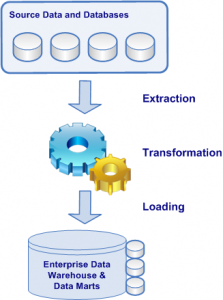Three Steps in ETL Processing
- The term ETL which stands for extraction, transformation, & loading is a batch or scheduled data integration processes that includes extracting data from their operational or external data sources, transforming the data into an appropriate format, and loading the data into a data warehouse repository. ETL enables physical movement of data from source to target data repository. The first step, extraction, is to collect or grab data from from its source(s). The second step, transformation, is to convert, reformat, cleanse data into format that can be used be the target database. Finally the last step, loading, is import the transformed data into a target database, data warehouse, or a data mart.
Step 1 – Extraction
The extraction step of an ETL process involves connecting to the source systems, and both selecting and collecting the necessary data needed for analytical processing within the data warehouse or data mart. Usually data is consolidated from numerous, disparate source systems that may store the date in a different format. Thus the extraction process must convert the data into a format suitable for transformation processing. The complexity of the extraction process may vary and it depends on the type and amount of source data.
Step 2 – Transformation
The transformation step of an ETL process involves execution of a series of rules or functions to the extracted data to convert it to standard format. It includes validation of records and their rejection if they are not acceptable. The amount of manipulation needed for transformation process depends on the data. Good data sources will require little transformation, whereas others may require one or more transformation techniques to to meet the business and technical requirements of the target database or the data warehouse. The most common processes used for transformation are conversion, clearing the duplicates, standardizing, filtering, sorting, translating and looking up or verifying if the data sources are inconsistent.
Step 3 – Loading
The load is the last step of ETL process involves importing extracted and transformed data into a target database or data warehouse. Some load processes physically insert each record as a new row into the table of the target warehouse utilizing a SQL insert statement. Whereas other load processes include a massive bulk insert of data utilizing a bulk load routine. The SQL insert is a slower routine for imports of data, but does allow for integrity checking with every record. The bulk load routine may be faster for loads of large amounts of data, but does not allow for integrity check upon load of each individual record.


